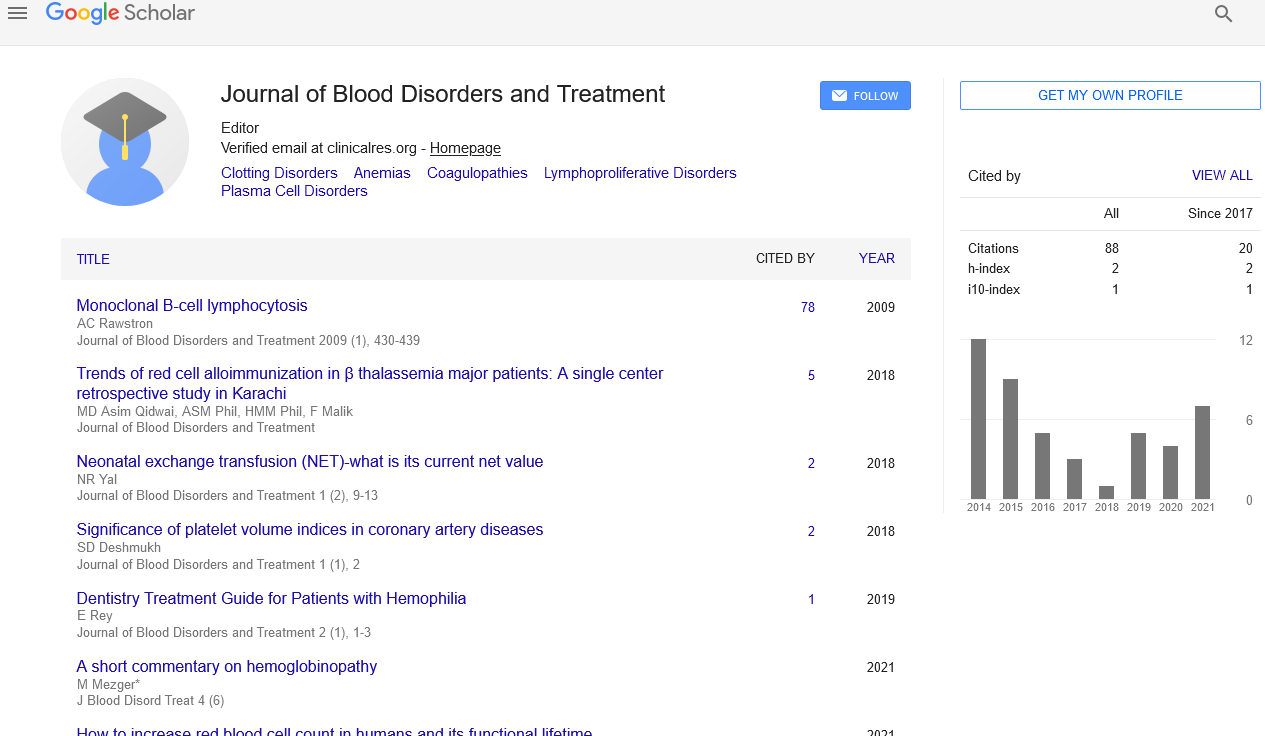X-linked lymphoproliferative syndrome
Received: 04-Feb-2023, Manuscript No. puljbdt-23-6256; Editor assigned: 06-Feb-2023, Pre QC No. puljbdt-23-6256 (PQ); Accepted Date: Feb 25, 2023; Reviewed: 10-Feb-2023 QC No. puljbdt-23-6256 (Q); Revised: 12-Feb-2023, Manuscript No. puljbdt-23-6256 (R); Published: 28-Feb-2023, DOI: 10.37532/puljbdt.2023.6(1).07-08
Citation: Van A. X-linked lymphoproliferative syndrome. J. Blood Disord Treat. 2023;6(1):09-10.
This open-access article is distributed under the terms of the Creative Commons Attribution Non-Commercial License (CC BY-NC) (http://creativecommons.org/licenses/by-nc/4.0/), which permits reuse, distribution and reproduction of the article, provided that the original work is properly cited and the reuse is restricted to noncommercial purposes. For commercial reuse, contact reprints@pulsus.com
Abstract
XLP1 is a condition with numerous and diverse clinical effects, such as deadly hemophagocytic lymphohistiocytosis (HLH), which is primarily caused by the Epstein-Barr virus, lymphomas, an inability to produce enough antibodies, and less common effects of immune dysregulation.
Keywords
Hemophagocytic; Lymphoproliferative; Antibodies
Introduction
A male-specific apparent genetic disorder that develops quickly into death after Epstein-Barr virus (EBV) infection. Although there was significant evidence for X-linkage, there was no proof of the disease in two or more generations in either report. Pediatric patients were engaged in many of the cases. One study found that none of the sisters of the six male maternal cousins who died of this illness out of 18 who were born within one generation.
A proliferation of lymphocytes and histiocytes, a variety of hepatic abnormalities, and changes in serum immunoglobulins varying from agammaglobulinaemia to polyclonal hyper gammaglobulinaemia were the disease's hallmarks. Two of the cousins, who were also halfbrothers from different dads, had central nervous system and ileal lymphomas. After the surname of the family, it was suggested to designate the condition X-linked recessive progressive combined variable immunodeficiency or Duncan's disease.
The immune system and blood-forming cells are affected by X-linked Lymphoproliferative disease (XLP), which affects almost solely men. Exaggerated immune responses to the Epstein-Barr Virus (EBV) occur in more than half of those who have this disease. The majority of people ultimately contract the extremely prevalent EBV virus. It can lead to infectious mononucleosis in some individuals (Commonly known as "mono"). EBV typically persists in specific immune system cells (lymphocytes) known as B cells after the original infection. But because it is under the control of other lymphocytes called T cells that particularly target B cells with EBV infection, the virus is typically dormant (latent).
Based on the genetic cause and pattern of signs and symptoms, there are two kinds of XLP: XLP1 (also known as classic XLP) and XLP2. People with XLP2 are more prone to develop hemophagocytic lymphohistiocytosis without having EBV infection, typically have an enlarged spleen (splenomegaly), and may also have inflammation of the large intestine. They have not been known to develop lymphoma (colitis). Some experts think that rather than a specific form of XLP,these people should be thought to have a comparable but distinct disorder.
Based on its genetic cause and pattern of signs and symptoms, the rare recessive genetic disease known as X-linked lymphoproliferative (XLP) syndrome can be divided into two types. Mutations in the SH2D1A gene lead to X-linked lymphoproliferative syndrome type 1 (XLP1), also referred to as typical XLP; mutations in the XIAP gene lead to lymphoma, XLP type 2 (XLP2). dysgammaglobulinemia, Hemophagocytic Lympho Malignant severe Histiocytosis (HLH) (or serious mononucleosis) brought on by the Epstein-Barr Virus (EBV), common variable immunodeficiency, and (CVID). Malignant cancer and CVID have not been identified in XLP2.
One to three men out of every million are thought to be affected by XLP. Males with fatal fulminant infectious mononucleosis (FIM) are not always evaluated for XLP, so the illness is likely underreported. There is no preference based on race or ethnicity.
The main immunodeficiency known as X-linked lymphoproliferative disease (XLP) is uncommon. Typically, those who are infected with the Epstein-Barr virus do not initially exhibit any symptoms of illness. Dysgammaglobulinaemia, lymphoma, and fulminant infectious mononucleosis are the most prevalent clinical symptoms. (Usually Bcell origin). The intracellular adaptor molecule SAP (Signaling Lymphocyte Activation Molecule (SLAM) related protein) is encoded by the SH2D1A gene, which is where XLP is brought on by mutations. The role of SAP is to regulate signal transduction pathways downstream of the SLAM family of surface receptors to control CD4+ T-cell (and consequently B-cell), CD8+ T cell, and NK cell function, as well as the development of NKT cells. SAP is primarily expressed in T-cells and NK cells. As a result, SAP mutations lead to immune system dysregulation, with flaws in both cellular and humoral defense. Here, we present two clinical cases of three individuals who presented with various XLP manifestations, including hypogammaglobulinemia, Burkitt lymphoma, and fulminant infectious mononucleosis.
The main immunodeficiency known as X-linked Lymphoproliferative disease (XLP) is uncommon. The intracellular adaptor molecule SAP (signaling lymphocyte activation molecule- (SLAM-) linked protein), which is encoded by the SH2D1A gene, is the cause. These result in immune dysregulation most frequently as a result of inefficient interactions between T-cells and NK cells and B-cells, the Epstein-Barr Virus (EBV), or other unknown antigenic triggers. Both humoral immunity (abnormal immunoglobulin levels and abnormal antibody reactions to infections and vaccinations) and cellular immunity (cytotoxic T lymphocyte and NK cell dysfunction leading to reduced cytokine production) are dysfunctional in XLP. Haemophagocytic Lympho Histiocytosis (HLH), dysgammaglobulinaemia, and lymphoma are the most typical clinical symptoms of XLP; however, aplastic anemia, vasculitis, chronic gastritis, and skin lesions have also been reported. The majority of patients, in spite of their underlying immunologic abnormalities, are symptom-free previous to presentation, and it is typically an EBV infection that sets off the clinical manifestations. This may be due to the virus B-cell tropism. EBV can cause B-cell and T-cell lymphomas, Hodgkin lymphoma, and Burkitt lymphoma in some populations, especially in immunocompromised individuals. After infection, EBV stays latent in B cells for the entirety of the patient's life.





